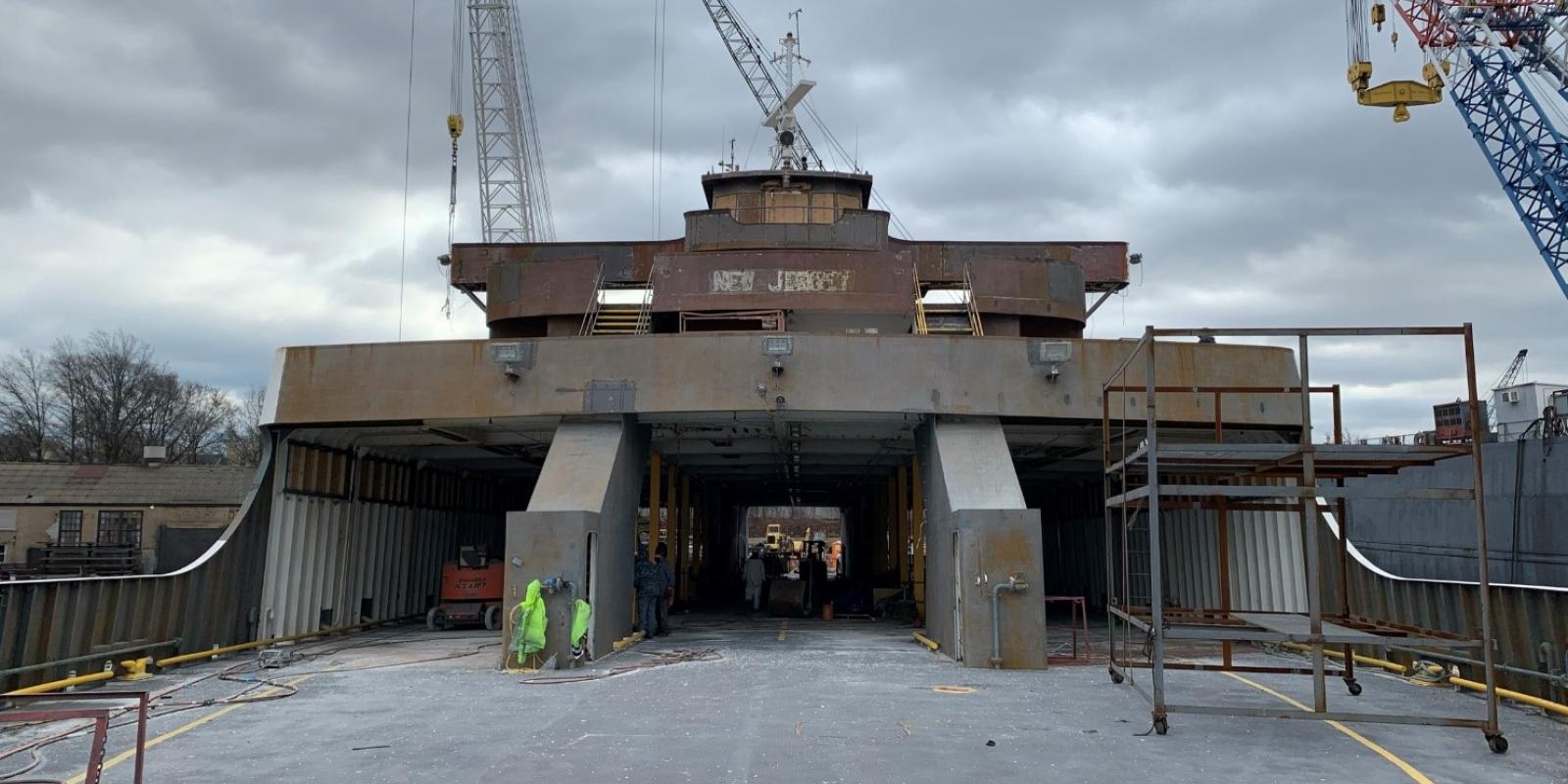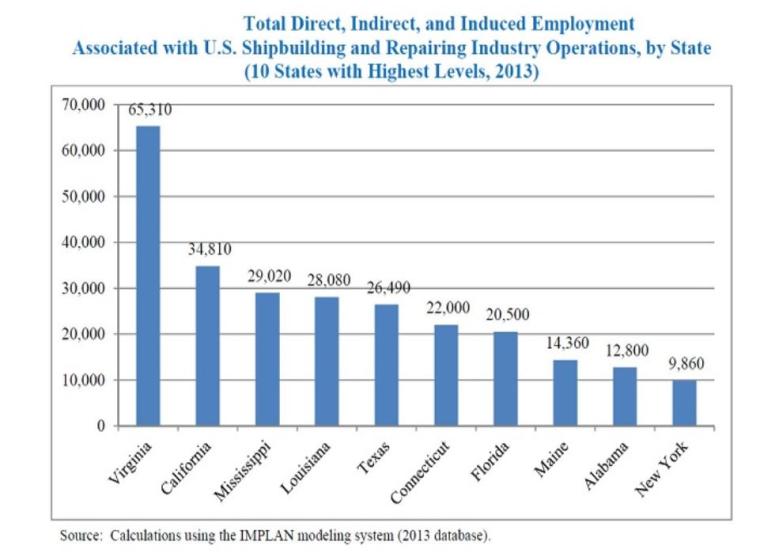
Shipbuilding in the U.S.
The Shape of Shipyards
With the M/V New Jersey undergoing a complete lifecycle extension at the shipyard in Staten Island and the 2021 start of the Marine Master plan for the ferries of the future, it's a good time to look at the role of shipyards.
It's a story we don't frequently tell and one that is both steeped in history, global defense positioning, and economic implications. If you buy a car, it's important to know if there are mechanics and service stations nearby. Similarly, if you have a boat, it's good to know the state of shipyards that help build and keep those boats in peak condition.
Shipyards and the Economy
Currently, there are 124 shipyards in the US across 26 states. Per a 2021 article in Maritime Executive, industry studies show shipyards support approximately 110,000 jobs across all 50 states and contribute $37.3 billion to the national Gross Domestic Product (GDP).
An industry forecast by IBISWorld, a global business market research firm, anticipates continued shipyard growth through 2026 to support the need for defense, passenger and commercial vessels ranging from barges, submarines, tugboats, and fishing vessels to ferries like those that will be commissioned for the Cape May-Lewes Ferry. Nonetheless, the number of shipyards in close proximity to our ports that can handle our size and type of vessel are limited.
The chart below, taken from an economic study on the shipping industry in 2013 shows the top 10 states with shipbuilding capabilities, with the top 5 accounting for almost two-thirds of all private shipbuilding employment. For every shipbuilding job in the U.S., three indirect jobs are supported. Virginia, which tops the chart, is home to General Dynamics, the largest shipbuilder in the country and one that caters to specialty naval vessels.

Finding Local Expertise
The lack of local resources is one of the reasons the Cape May-Lewes Ferry has a robust marine shop on premises for minor repairs. It's why when a ferry from Martha's Vineyard was sailing to a Chesapeake shipyard years ago and broke down in transit, repairs were done by the Cape May-Lewes Ferry team as the closest marine mechanics able to assist getting the Massachusetts ferry back underway.
Currently, the closest shipyards for larger types of mechanical repairs for our sized vessels are in Philadelphia followed by Staten Island, where the M/V New Jersey is currently being refurbished. Although some shipyards are closer to Cape May, they don't have dry docks large enough for CMLF vessels and are generally designed to support smaller boats.
In 2017, the M/V NJ docked at Dorchester Shipyard near Port Norris, NJ -- located where the Delaware River flows into the Delaware Bay -- for steelwork and painting upgrades. The repairs did not require full dry docking, and Dorchester, proud of winning the paint contract, published the YouTube video below.
Where are the DE and NJ Shipyards?
You may notice that the current CMLF fleet carries the words "Wilmington, DE" on their bows. This is a tribute to the DRBA's Delaware roots, but also the deep history of ferry boat building and passenger services that came out of Wilmington shipyards. Today, the Port of Wilmington is better known for cargo vessels as is the the nearby Port of Camden, but at one time both were major shipbuilding centers.
Camden was important in WWII efforts, responsible for the launch of several legendary battleships including the USS South Dakota, USS Kitty Hawk, and 98 landing craft used at Normandy Beach. Ironically, the Camden shipyard was built in 1899 by Henry Morse, an engineer who originally wanted to have his shipyard in Staten Island but couldn't find a suitable site. He subsequently named his Camden yard on the Delaware River -- New York Shipbuilding Corporation!
Delaware's shipbuilding history is based in Wilmington due to its proximity to both the Delaware and Christiana Rivers. At one time, there were four major shipbuilding plants along the Christiana and in WWII, Wilmington shipyards specialized in small water invasion craft and the famous Higgins boats, called the "boats that won the war." Click the thumbnail below for a piece from CBS Sunday Morning on Higgins boats and how they were inspired by shallow draft skiffs on the Louisiana Bayou.
Wilmington Ferry Lines
Of all the local DE and NJ shipping locations of yesteryear, Wilmington was the one that became known for shipyards that catered to ferry lines. Ferries in the Wilson Line, were built in Wilmington to take passengers up river to New Jersey and Philadelphia before rail and roadways could accommodate the traffic. The ferries specialized in day excursions.
Today's Debate
Today, the debate about shipyards involves the 1920 Jones Act, which requires that all goods and services shipped between US ports must be on ships built, owned, and operated by US citizens and permanent residents. Designed to stimulate shipping after WWI, many economists, defense experts and others argue it has had the opposite effect and resulted in limiting US maritime growth.
The Jones Act has been cited in limiting trade and emergency response to Puerto Rico and affects the ability of American shipping lines to import services when needed. For future marine master planning at the CMLF, it means any boats ordered for our line will come from one of just a few available shipbuilders, as most US shipyards specialize in smaller boats or deep-water Navy vessels, with many ferry specialists currently located in Europe. This is one reason the Marine Master plans and designs provided by naval architecture consulting firm Elliott Bay must take into account shipbuilding capabilities available within U.S. shores as part of their consideration and recommendations.
To receive e-mail updates on the CMLF Marine Master Plan as it develops, sign up using the button below.
